Annual Report 2017-18: Building tomorrow’s public service today

Message from the Commissioners
Message from the Commissioners: Highlights from the report
Message from the Commissioners: Highlights from the report
For over a century, the Public Service Commission of Canada has been charged with promoting and safeguarding merit-based appointments and protecting the non-partisan nature of the federal public service. Under the delegated staffing system set out in the Public Service Employment Act, we fulfill our responsibilities by providing policy guidance and expertise, conducting oversight, delivering innovative staffing and assessment services, and reporting to Parliament on the performance of the staffing system and on non-partisanship in the public service. Fulfilling our role provides us with a unique perspective and valuable information which, in turn, shapes the way we influence the federal public service staffing system.
We are mindful that:
- We provide an essential foundation for service excellence and trust in government. Only through merit-based hiring, free from political influence, are we able to attract and develop the talent needed to provide first-rate programs and services to all Canadians.
- We are the first point of contact for Canadians beginning a career in the public service. From our early outreach efforts, to our recruitment programs, to an individual’s experience navigating the application process, the extent to which prospective employees feel included or excluded reflects on us.
- We play a key role in building a diverse workforce. Shaping a public service that reflects the rich diversity of Canada depends on our success in attracting and recruiting qualified Canadians from all backgrounds across the country.
We are not alone in these responsibilities. While we hold the legal authority to appoint public servants, we delegate this authority to deputy heads, and we rely on individual departments and agencies to carry out staffing to meet their business needs. We continue to encourage departments, agencies and ourselves to move beyond traditional approaches and to modernize, to remain competitive as a recruiter and as an employer.
To that end, 2 years ago, we launched the New Direction in Staffing, a renewed policy framework that provides departments and agencies with more opportunities to exercise managerial discretion in staffing. The new framework simplified staffing rules and reduced the number of staffing policies from 12 to1. We made these changes to encourage hiring managers to apply their judgment when staffing, and to work with human resources professionals as strategic partners in the hiring process.
Building on this policy foundation, this year, we embarked on a transformation of the public service recruitment system. We began with extensive consultations with all those involved in hiring, starting with candidates, to learn what they expect and need. This user-design approach has created a blueprint for an updated recruitment platform.
Beyond the recruitment system, we’re also experimenting with our approach to staffing. For instance, we’re working collaboratively with departments and agencies to simplify how we assess second language proficiency. We also piloted anonymized recruitment to assess the impact of concealing information about candidates’ origins during the hiring process.
Departments and agencies are taking up the challenge of modernization. We’re seeing them experiment with more innovative ways to attract new and diverse talent, in order to build a more agile workforce that can meet the challenges of today — and tomorrow.
This progress leaves us hopeful, but not complacent. We know that much more work remains to be done. There is ample evidence that changing culture and approach requires long-term commitment and sustained attention. We know how difficult it is, but we believe that we have no alternative. For example, it still takes far too long to hire. In an environment where there is fierce competition for talent, we cannot make candidates wait months, often with little communication about the process and their status.
While we need to develop and promote members of our existing workforce, we also need to draw on the talent, new ideas and diversity that are gained by recruiting from outside our ranks. This must be done in a way that is inclusive and that upholds our values.
Findings from our System-Wide Staffing Audit indicate that hiring practices in the public service continue to be based on merit and remain non-partisan. These findings allow us to support inclusive, simplified and more effective hiring.
In this year’s report, we highlight departments and agencies that are challenging the status quo and describe new practices that are worth exploring. Through innovation and experimentation, we want to continue working with hiring managers, deputy heads and staffing advisors to further transform federal public service recruitment and hiring.
Patrick Borbey
President
Fiona Spencer
Commissioner
D. G. J. Tucker
Commissioner

Hiring and the workforce of the future
We have no choice: we must hire better, we must hire more, we must hire faster — and we must continue to hire a diverse and qualified workforce.
A large proportion of our indeterminate employees are over the age of 50. Canadians under the age of 35 currently represent about 36% of the labour forceFootnote F1, compared to only 16% of indeterminate employees in the public service. Anticipating that millennials and future generations will dominate the labour force over the next decade as the baby boomers retire, we need to do a better job of attracting and retaining this portion of the population. Renewal is not optional; it is imperative.
We’re making strides in the right direction.
Our student programs remained strong, with close to 13 000 hires — increasing for the fifth consecutive year. Hiring students remains a top priority, as they represent the future of the public service.
We continue to bring in the next generation of talent through our Post-Secondary Recruitment program, which attracted almost 16 000 applicants in 2017–18. While the program saw a small increase in indeterminate hires this year, a decrease in term hires meant that overall hiring to this program declined for the first time in 4 years.
Post-Secondary Recruitment Program
711
-7.8%
| Indeterminate | 466 | +5.9% |
|---|---|---|
| Term | 245 | -26.0% |
Student Recruitment Programs
12 749
+4.0%
| Federal Student Work Experience Program | 7 489 | +2.8% |
|---|---|---|
| Post-Secondary Co-op/Internship Program | 4 980 | +7.2% |
| Research Affiliate Program | 280 | -15.4% |
2017–18 Total Hiring Activity into the Public ServiceEndnote E1
53 361
+11.4%
| Indeterminate | 8 226 | +32.1% |
|---|---|---|
| Term | 12 316 | +12.1% |
| Casual | 20 070 | +9.0% |
| Student | 12 749 | +4.0% |
Public Service Employment Act population
211 345
+4.3%
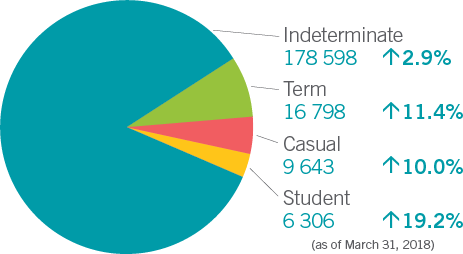
Text Alternative
| Indeterminate | 178 598 | +2.9% |
|---|---|---|
| Term | 16 798 | +11.4% |
| Casual | 9 643 | +10.0% |
| Student | 6 306 | +19.2% |
Did you know?
16.6% of all indeterminate and term hires had experience in a federal student employment program within the last 10 years.
Partnering with Canadian universities
The Public Service Commission of Canada worked with the University of Victoria to:
- enhance students’ job search experience
- try out new ways to match students with federal public service jobs
- match students' skills and interests with recruitment needs by drawing on data from the labour market
We will learn from this initiative and look to extend it to other universities across Canada.
Did you know?
16.6% of all indeterminate and term hires had experience in a federal student employment program within the last 10 years.
Partnering with Canadian universities
The Public Service Commission of Canada worked with the University of Victoria to:
- enhance students’ job search experience
- try out new ways to match students withfederal public service jobs
- match students' skills and interests with recruitment needs by drawing on data fromthe labour market
We will learn from this initiative and look to extend it to other universities across Canada.
This is evident through the work of the Deputy Minister University Champions. This network allows deputy ministers from across government to build relationships with universities, identify shared priorities and explore opportunities for partnerships.
Relationships like these increase the visibility of our recruitment programs and hiring needs, raise awareness of career opportunities in the federal public service and support our branding and recruitment activities.
Despite these efforts, the public service remains too insular in its hiring practices. A minority of public service job advertisements (36.7%)Endnote E2 are open to the general public. This is in contrast to other countries such as New Zealand, Australia and the United Kingdom, where all federal public service staffing processes are, or will soon be, external by default.
While developing our existing talent is important, it should be complemented by bringing in new skills and building a more diverse workforce. We need to find the right balance to achieve a sustainable staffing model for the public service.
Significant hiring continues in administrative and policy areas, the foundation of the public service workforce. We’ve also seen a large increase in hiring into the Computer Systems group, putting it in the top 5 hiring groups for the first time in recent years.
This reflects our new reality — the federal public service is competing for emerging skills in the Canadian job market, which means our recruitment practices need to be nimble and effective.
Public service Hiring – Top 5 occupational groupsEndnote E3
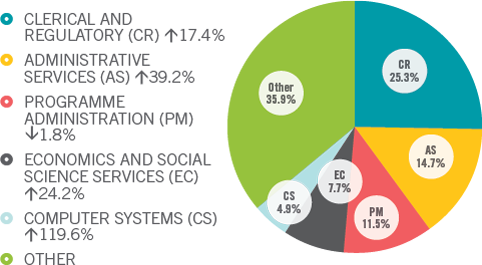
Text Alternative
| Occupational group | % of all indeterminate and term hiring | Year-over-year change (%) |
|---|---|---|
| CR – Clerical and Regulatory | 25.3% | +17.4% |
| AS – Administrative Services | 14.7% | +39.2% |
| PM – Programme Administration | 11.5% | -1.8% |
| EC – Economics and Social Science Services | 7.7% | +24.2% |
| CS – Computer Systems | 4.9% | +119.6% |
| Other | 35.9% | +13.8% |
Public service Population – Top 5 occupational groupsEndnote E3
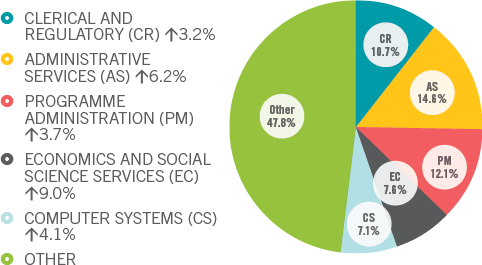
Text Alternative
| Occupational group | % of all indeterminate and term population | Year-over-year change (%) |
|---|---|---|
| CR – Clerical and Regulatory | 10.7% | +3.2% |
| AS – Administrative Services | 14.6% | +6.2% |
| PM – Programme Administration | 12.1% | +3.7% |
| EC – Economics and Social Science Services | 7.6% | +9.0% |
| CS – Computer Systems | 7.1% | +4.1% |
| Other | 47.8% | +2.0% |
Experimenting with Staffing at Shared Services Canada
Experimenting with Staffing at Shared Services Canada
While we must continue to hire from the new generations, we also need to focus on recruiting mid-career employees with proven expertise and knowledge. This is a need that departments and agencies clearly recognize.
This year departments and agencies launched a range of initiatives aimed at:
- shifting towards a more agile workforce
- experimenting with new methods to attract highly qualified candidates
- discovering new and effective approaches for assessment
In our efforts to recruit, we’re also addressing perceptions, myths and some hard realities. While departments and agencies have been promoting the dynamic and diverse nature of public service careers, lengthy and complex hiring processes remain the norm. Even with a simplified policy framework intended to reduce red tape, on average it actually took longer to recruit into the public service in 2017–18. This affects the public service brand, deters quality candidates from applying or potentially loses them along the way.
Despite this, we’re seeing progress in some areas. Now that departments and agencies have more opportunities to exercise discretion, they’re creating simpler and more attractive job advertisements, which is leading to faster staffing, and a better experience for candidates. Managers have also begun to explore new ways beyond the typical advertisement to attract talent and find candidates who aren’t actively searching for a change. This may in part explain the increase in non-advertised appointments, representing 34% of hires, up from 25% last fiscal year.Endnote E4
Quebec region – Pilot speed-staffing recruitment
A pilot event was organized at the University of Montreal to promote the public service as an employer of choice, connecting students and recent graduates with hiring managers. The event aimed to fill hard-to-staff positions and to increase placements through our Post-Secondary Co-op/Internship Program.
Students and graduates were invited to the event for interviews.
Highlights
- 82 interviews by 10 departments
- 32 graduates received on-the-spot conditional offers for term and indeterminate positions
- 4 students received offers for Co-op placements
- Security clearance process launched onsite
- Hiring process completed within a month
Staffing within the public service
In addition to hiring into the public service, the Public Service Commission of Canada oversees internal appointments, including acting appointments and promotions for public servants. Internal opportunities are key to successfully developing and retaining employees, continuing to deliver on programs and offsetting departures.
The rate of promotions increased for the fifth year in a row to 11%, with just over 20 000 promotions. This is in contrast to the number of acting appointments (of more than 4 months), which has not seen as much growth over the last couple of years.
Many employees are moving laterally across the public service, rather than upward, with about one in 10 employees making a lateral move in 2017–18.
Internal mobility ratesEndnote E5
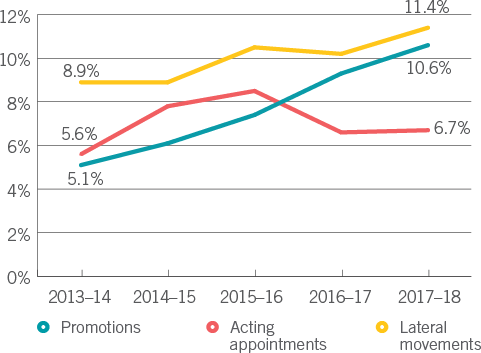
Text Alternative
| Fiscal year 2013 to 2014 | Fiscal year 2014 to 2015 | Fiscal year 2015 to 2016 | Fiscal year 2016 to 2017 | Fiscal year 2017 to 2018 | |
|---|---|---|---|---|---|
| Promotion rate | 5.05% | 6.08% | 7.37% | 9.34% | 10.64% |
| Acting appointment rate | 5.56% | 7.83% | 8.51% | 6.58% | 6.69% |
| Lateral movement rate | 8.85% | 8.86% | 10.50% | 10.21% | 11.35% |
#iwantasciencejob
Science-based departments and agencies worked together on a recruitment model that challenged conventional staffing and targeted high-potential science graduates and professionals.
This experimental hiring strategy:
- used modern and innovative assessment tools to better evaluate soft skills, among others, and to speed up the staffing process
- resulted in an inventory of 944 candidates from across Canada (68% have a graduate degree or higher, and nearly 60% are members of one or more employment equity groups)
- saw the team win the 2017 Michelle C. Comeau Award for teamwork in human resources for their ambitious goal, innovative approaches and collaboration
Collaboration, innovation and experimentation
We’re transforming the staffing system through innovation and experimentation. This includes modernizing the recruitment process, where we play a significant role. Our recruitment system connects candidates with employment opportunities and facilitates their application, and their second official language proficiency is evaluated by our language assessors.
In 2017–18 the federal public service received applicationsEndnote E6 from 324 376 individuals for 2 801 job advertisements open to the public through our GCJobs website. For each job opportunity, candidates had to complete a detailed application, often a complex and time-consuming process. If unsuccessful, candidates rarely heard back from departments and agencies due to large volumes of applications. While our government recruitment platform should be a tool to attract candidates, it currently does not meet the expectations of candidates and therefore needs to be modernized.
To address this critical shortcoming, we launched the New Direction in Staffing Interface (NDSi) in April 2017. This innovative initiative sought to improve the recruitment and job application process within the Government of Canada. The goal is to fundamentally modernize how hiring managers and applicants connect, by making the recruitment process more efficient, effective and user-friendly.
As part of this initiative, we collaborated and experimented with candidates, hiring managers and human resources professionals across the public service in over 100 outreach and engagement sessions. Throughout these sessions, users told us what they wanted from a new recruitment system. We tested their requirements, and we’re using them to identify the best replacement for the antiquated recruitment platform.
We also launched a pilot in 2017–18 to allow hiring managers, instead of Public Service Commission second language assessors, to assess candidates’ proficiency at the most common bilingual profile (the intermediate level of a candidate’s spoken second official language). We’ll study the results of the pilot to see whether the approach could work across the public service. These results could lead to major time savings in second official language evaluation.
What applicants, hiring managers and human resources professionals want from a new recruitment system
- Plain and simple language
- A system that stores and reuses information so that they can advertise, search and apply for jobs more quickly and easily
- Accessible information about the labour market, supply and demand
Second language evaluation pilot departments and agencies
- Canada Economic Development for Quebec Regions
- Canada Revenue Agency
- Canadian Heritage
- Canadian Space Agency
- Department of Justice (Quebec regional office)
- Elections Canada
- Employment and Social Development Canada
- Fisheries and Oceans Canada
- National Defence
- Public Service Commission of Canada
International partnerships
Each year, we share our expertise with a range of international delegations. These exchanges allow us to share our experiences in recruitment, our expertise in assessment, and our strength in establishing a non-partisan public service. Through these international partnerships, we also learn from leaders in organizations outside Canada.
This year, we met with our counterparts from Australia and New Zealand to discuss diversity and recruitment. The work of these governments to ensure the inclusion of Indigenous peoples, persons with disabilities and members of the LGBTQ2+ (lesbian, gay, bisexual, transgender, queer, and 2-spirit) community has provided us with insight for future initiatives. We’ve also been engaging with Ireland’s public service to learn more about their leading practices in personality testing and remote supervised testing.
In 2018, we initiated a partnership with Code for Canada to create a new electronic management in-basket test — a comprehensive assessment of candidates’ competencies in a simulated work situation — to ensure that the evaluation experience is accessible and seamless.
“Imagine if we had started talking about inclusion, it would have naturally led to diversity. With the other way around, it is always a numbers game.”
Code for Canada
The Code for Canada fellowship is modelled after similar programs from around the world, including the United States and Australia. In Canada, technology professionals from across the country are embedded in departments and agencies to work alongside public servants on digital transformation projects. The Government of Canada has partnered with Code for Canada and is hosting teams of fellows in Transport Canada, Veterans Affairs Canada and other departments.
Anonymized Recruitment Pilot
Inspired by similar national and international initiatives, we partnered with the Office of the Chief Human Resources Officer on the Anonymized Recruitment Pilot Project. The goal was to see whether concealing personal information that could identify a person’s origin had any impact on screening decisions, when compared to the way candidates are usually assessed, where all personal information is presented.
Highlights
- Results from 27 job processes open to the public, across 17 participating departments, were examined
- Over 2 200 candidates were involved, of which 685 self-declared as a visible minority
- 54 managers and reviewers (2 per process) participated in the screening process of candidates
Results released in January 2018 showed that anonymizing application information decreased the overall screened-in rates in external recruitment processes included in the pilot, but resulted in no net benefit or disadvantage for candidates who self-declared as a visible minority. To complement these results, we are undertaking an audit to explore the success rate of employment equity groups at key steps of the recruitment process.
Building a diverse and inclusive public service
Over the past 20 years, the federal public service has made important progress in the representation of the 4 designated employment equity groups — women, Aboriginal peoples, persons with disabilities and members of visible minorities.
Yet gaps persist. While women now represent the majority in the public service, they are still not well represented in technical and operational occupations, including engineering, and labour and trades. At the executive level, only persons with disabilities exceed their availability in the workforceFootnote F2. These examples highlight the work that still needs to be done, and they guide our strategies to build a more diverse and inclusive workforce.
Employment equityEndnote E7
Applicants to advertised processes, compared to 2011 workforce availability

Text Alternative
| Persons with disabilities | Aboriginal peoples | Members of visible minorities | Women | |
|---|---|---|---|---|
| Applicants | 2.9% | 3.3% | 22.2% | 53.7% |
| 2011 workforce availability | 4.4% | 3.4% | 13.0% | 52.5% |
This year, in partnership with the Office of the Chief Human Resources Officer, 2 programs continued to support a more inclusive, diverse and accessible public service.
The Indigenous Student Employment Opportunity was introduced as a pilot in the National Capital Region in 2016, and then in February 2018, it was expanded across Canada, resulting in departments and agencies hiring 186 Indigenous students for the summer of 2018. This program provides Indigenous youth with valuable work experience close to where they live or go to school. Hiring talented and promising Indigenous students brings new perspectives, a spirit of collaboration and innovative ideas to the workplace, while also contributing to the Government of Canada’s priority to renew the relationship with Indigenous people.
The Youth Accessibility Summer Employment Opportunity encourages students with disabilities to consider a career in the public service by highlighting potential career pathways and the support that is available. It also creates positive early career experiences for students with disabilities. This year’s program resulted in 61 hires for the summer of 2018.
“Building an inclusive workforce starts with recruitment. When done right, recruitment can act as an accelerant to bring about change.”
Accommodations in recruitment processes
Each year, our Personnel Psychology Centre works with departments and agencies to support requests for assessment accommodation. These are designed to enhance the accessibility of the assessment so individuals with a disability can fully demonstrate their qualifications.
There are many different types of assessment accommodations, depending on the specific needs of the candidate. Examples include:
- facilitating the use of a screen reader, a braillewriter, or other adaptive equipment during a test
- allowing a person with dexterity problems to mark their answers directly into the test booklet, rather than using the standard multiple-choice answer sheet
In 2017–18, we reviewed 2328 accommodation requests.
Indigenous Student Employment Opportunity: Jon-Evan Quoquochi
Youth Accessibility Summer Employment Opportunity: Brianna Jennett-McNeil
Official language requirements
The vast majority of employees meet the language requirements of their bilingual position. As of March 31, 2018, only 8 employees had not achieved the language requirements during the established time limit.
Official language requirements
The vast majority of employees meet the language requirements of their bilingual position. AsofMarch 31, 2018, only 8 employees had not achieved thelanguage requirements during theestablished time limit.
To foster a diverse and inclusive public service, we must expand our focus beyond meeting targets, and make sure that the way we recruit allows candidates to participate fully in all aspects of the appointment process. Retaining these candidates is also key to ensuring our public service continues to benefit from diversity.
We are increasingly called upon to expand our view of diversity beyond the 4 existing employment equity groups. We’ve continued to see an increase in hires in the National Capital Region, but we understand that regional representation is equally important to service excellence. We must continue to attract and hire regional candidates, and to retain regional employees, to build a diverse public service.
Recruiting people who can serve Canadians in the official language of their choice is also an important part of our work. We support building a bilingual workforce by conducting second language evaluations — over 88 000 a year. We’re also engaging with official language minority communities to promote linguistic duality, increase their application rates, and better understand their needs and challenges. In 2017–18, through outreach activities, our regional offices engaged with 35 associations within these communities across Canada.
| Regions | Hires | PSEA PopulationFootnote * |
|---|---|---|
| 1. British Columbia | 3 576 | 17 353 |
| 2. Alberta | 2 195 | 11 045 |
| 3. Saskatchewan | 980 | 4 853 |
| 4. Manitoba | 1 209 | 6 897 |
| 5. Ontario (except NCR) | 4 573 | 25 838 |
| 6. National Capital Region (NCR) | 25 111 | 96 096 |
| 7. Quebec (except NCR) | 5 014 | 22 235 |
| 8. New Brunswick | 2 205 | 8 113 |
| 9. Nova Scotia | 2 338 | 9 095 |
| 10. Prince Edward Island | 456 | 1 882 |
| 11. Newfoundland and Labrador | 1 039 | 3 424 |
| 12. Yukon | 99 | 318 |
| 13. Northwest Territories | 79 | 418 |
| 14. Nunavut | 58 | 246 |
| 15. Outside Canada | 87 | 1 397 |
|
||
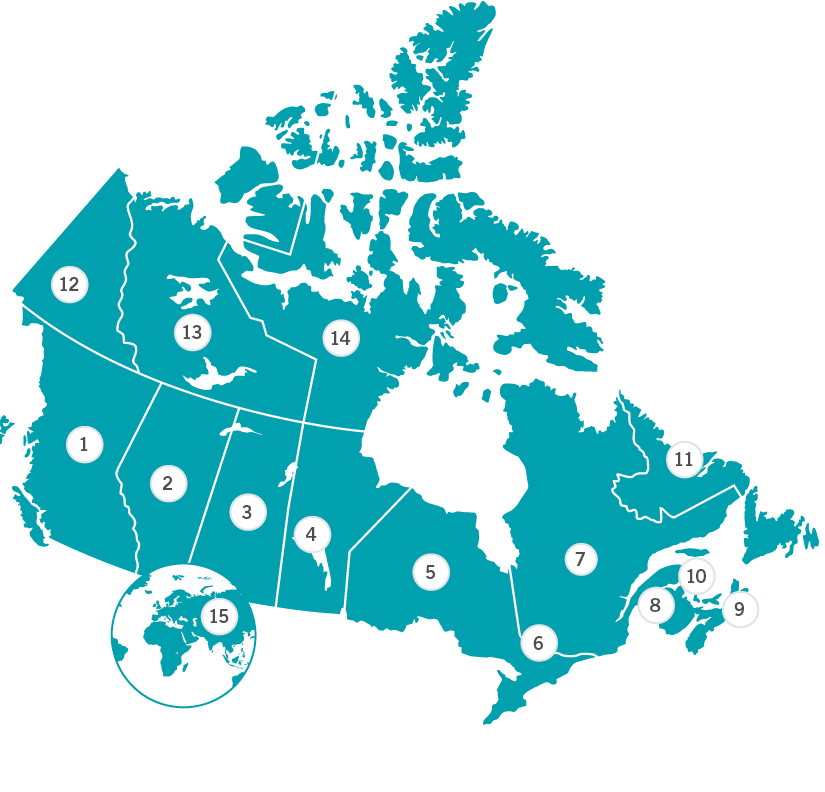
Priority hiring and veterans in the public service
Veteran Hiring
545
+10.8%
| Priority entitlement | 237 hires | +10.7% |
|---|---|---|
| Mobility | 193 hires | +16.3% |
| Preference | 115 hires | +2.7% |
Veteran Hiring
545
+10.8%
| Priority entitlement | 237 hires | +10.7% |
|---|---|---|
| Mobility | 193 hires | +16.3% |
| Preference | 115 hires | +2.7% |
Priority entitlements are integral to the Public Service Employment Act. They provide continuity of employment, help departments and agencies retain skilled employees and help veterans find jobs in the public service. Managers must hire a qualified person with a priority entitlement before all others. Those who qualify for a priority entitlement include, but are not limited to:
- Canadian Armed Forces members released for medical reasons
- employees declared surplus or laid-off
- employees returning from a leave of absence
- employees who became disabled
- Royal Canadian Mounted Police who were released for medical reasons
After several years of increases, and despite an increase in overall hiring, appointments of individuals with a priority entitlement dropped by 8% in 2017–18. However, we are encouraged to note that the number of persons with an active priority entitlement continues to decrease, and that priority appointments of medically released veterans remain relatively strong, with 237 appointments in 2017–18. Medically released veterans are the only priority entitlement group whose population is steadily rising, now accounting for 33% of all individuals with a priority entitlement.
Apart from the priority entitlement for medically released veterans, all qualified veterans must be hired ahead of other candidates in processes open to the general public (through a mechanism known as a preference), and are given the opportunity to apply to jobs open only to public servants (through a mechanism known as the mobility provision). Outreach efforts and cross-government collaboration represent a solid foundation for placing veterans in public service jobs, and have led to an 11% increase in the number of veterans hired in 2017–18. While this increase is a positive step, we will continue to work with veterans, Veterans Affairs Canada and other departments and agencies to better understand veterans’ needs and to introduce innovative approaches to meeting those needs.
Priority entitlements: population and hires
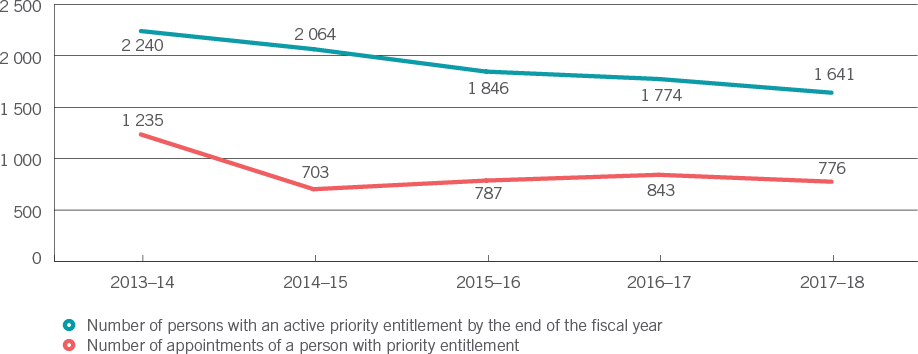
Text Alternative
| Fiscal year 2013 to 2014 | Fiscal year 2014 to 2015 | Fiscal year 2015 to 2016 | Fiscal year 2016 to 2017 | Fiscal year 2017 to 2018 | |
|---|---|---|---|---|---|
| Number of persons with an active priority entitlement by the end of the fiscal year | 2 240 | 2 064 | 1 846 | 1 774 | 1 641 |
| Number of appointments of a person with a priority entitlement | 1 235 | 703 | 787 | 843 | 776 |
Ensuring a merit-based and non-partisan public service
Our commitment to Open Government
As part of our commitment to Open Government, we regularly publish our oversight results, and we have also released over 60 data sets on topics that include hiring and staffing activities, applications to the public service, testing and assessment.
This information, as well as more detailed data from this report, is available to all Canadians on the Open Government portal.
Our commitment to Open Government
As part of our commitment to Open Government, we regularly publish our oversight results, and we have also released over 60 data sets on topics that include hiring and staffing activities, applications to the public service, testing and assessment.
This information, as well as more detailed data from this report, is available to all Canadians on the Open Government portal.
To support our accountability to Parliament for the integrity of the staffing system, we implemented a new system-wide approach to oversight in 2016, based on shared accountability with deputy heads. Our focus is on legislative, regulatory and policy requirements, while preserving deputy heads’ flexibility to adapt staffing strategies to their unique organizational context.
The Preamble of the Public Service Employment Act states that “Canada will continue to benefit from a public service that is based on merit and non-partisanship and in which these values are independently safeguarded.” Providing assurance on the integrity of more than 65 000 staffing actions each year and the rights and responsibilities of employees related to political activities is a critical task, and relies on our close collaboration with all stakeholders across the public service.
In 2017–18, we continued to implement our renewed system-wide approach to oversight, which includes system-wide staffing audits, horizontal risk-based audits and the Staffing and Non-Partisanship Survey.
System-Wide Staffing Audit
This year, we undertook our first System-Wide Staffing Audit, which examined 386 appointments across 25 departments and agencies to see how they complied with legislative, policy, and delegation requirements. We found that all 25 had built into their staffing systems the new requirements stemming from the New Direction in Staffing. We noted that in general departments and agencies were complying with key policy requirements. We also appreciated the considerable support and collaboration from the departments and agencies that participated.
While the overall findings were positive, we found that key staffing information (such as job advertisements and assessment tools) was not always accurate in both official languages. In many cases, we noted discrepancies between English and French information that could have had an impact on candidates’ participation in an appointment process.
The audit also showed that hiring managers and human resources professionals saw modest changes to the staffing culture within their departments. Although our new policy framework was intended to reduce red tape and provide departments and agencies with more discretion to customize staffing practices, more profound staffing culture change will take more time to achieve. It will also require more proactive change management strategies that promote responsible risk-taking in our approaches to staffing.
System-Wide Staffing Audit merit findings
As part of the System-Wide Staffing Audit, we examined 386 appointments to determine whether the person possessed the qualifications required for the position at the time of appointment.
The results were generally positive, with most appointments audited being made on the basis of merit.
There were 6 appointments, however, where the individual did not meet one or more of the qualifications. In 33 appointments, there was insufficient information to show that the individual met all the qualifications of the position.
We refer to deputy heads any internal appointment files in which issues have been found, so that they may take appropriate action. We monitor these files to ensure that appropriate action is taken. For external appointments, we may also choose to launch an investigation, if warranted.
Collaborative audit with Environment and Climate Change Canada
We collaborated with Environment and Climate Change Canada on an audit of key elements of their staffing and classification frameworks.
We both benefitted from this joint endeavour: our audit teams shared a common understanding of staffing requirements, as well as audit practices and tools.
Building oversight capacity
We have found that partnerships between the Public Service Commission and departments’ and agencies’ human resources and internal audit teams can be very effective in overseeing staffing. These partners benefit from their pooled expertise, and from a common understanding of staffing delegation and related legislative and policy requirements.
We’ve been partnering with human resources and internal audit teams to build staffing oversight capacity in departments and agencies across the public service. We worked closely with many of them during the System-Wide Staffing Audit and other oversight activities during the year.
We’ll continue to engage with departments and agencies, and with the human resources and internal audit communities, and to identify new opportunities to collaborate on staffing oversight.
Investigations
We also oversee individual staffing cases through investigations into staffing irregularities and allegations of improper political activities. In 2017–18, we received 178 requests to investigate fraud in internal and external appointment processes, as well as errors, omissions or improper conduct in external processes. This represents a 36% decrease from the previous year.
The number of cases of alleged fraud in staffing processes decreased significantly in 2017–18. This is due in part to our clearer distinction between improper conduct and fraud, and to our new approach of reserving fraud investigations for the most egregious cases. Of the 74 fraud investigations that were completed during this fiscal year, just over 50% were founded.
In 2017–18, we completed 13 investigations of errors, omissions or improper conduct in external appointment processes, and 5 were founded. Though this represents a small percentage of overall staffing, detecting and correcting significant irregularities ensures that all those involved in staffing — from candidates, to hiring managers, to human resources professionals — are held to account for their actions.
Deputy heads of departments and agencies can also request that the Public Service Commission investigate a case of error, omission or improper conduct on their behalf — and demand for these services is on the rise, given our dedicated resources and experience in this area.
A founded case of fraud
Our investigation found that an applicant provided falsified diplomas, language results, professional designations and information about their studies and professional experience. Due to the severity of this case, we disclosed details of the investigation to key organizations and ordered that the appointment be revoked.
A case of error, omission and improper conduct
At the request of a deputy head, we investigated and found that a lead assessment board member acted improperly by appointing a family member without disclosing the relationship. As a result, we recommended that the board member’s staffing authority be removed for 2 years, and that they take training on values and ethics, and staffing. We also recommended that the appointed family member be reassessed by an objective assessment board.
Modernizing investigations
The Public Service Employment Act calls for investigations to be conducted as informally and as expeditiously as possible. In 2017–18, we continued to reduce the length of our investigations. Overall, modernization has resulted in a 28.3% decrease in the median time required to complete an investigation since 2014–15.
Number of founded investigations cases
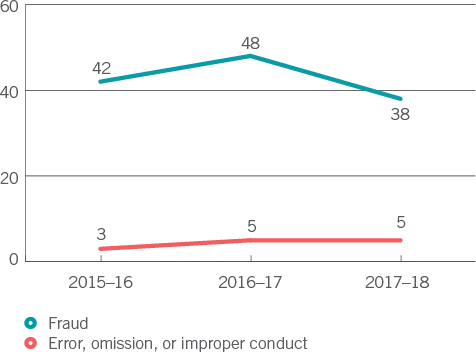
Text Alternative
| Error, omission, improper conduct | Fraud | |||||
|---|---|---|---|---|---|---|
| Fiscal year 2015 to 2016 | Fiscal year 2016 to 2017 | Fiscal year 2017 to 2018 | Fiscal year 2015 to 2016 | Fiscal year 2016 to 2017 | Fiscal year 2017 to 2018 | |
| Number of founded investigations cases | 3 | 5 | 5 | 42 | 48 | 38 |
Political Activities
Safeguarding the non-partisanship of the public service has been a critical component of our oversight mandate for the past 110 years. We conduct outreach and awareness activities and review requests for permission to seek nomination as, and be, a candidate in an election.
This year, we granted 97 requests for permission. Before granting permission, we complete a thorough analysis of each request and weigh the impact of the level of authority and the visibility of the public servant. We often set out conditions to mitigate the risk to impartiality, and collaborate with departments and agencies to ensure that those conditions are operationally sound.
We must balance the rights of public servants to engage in political activities with the importance of maintaining a public service that is impartial. In 2017–18, while 100% of permissions were granted, 49% included conditions such as leave without pay or a change in duties.
| Level | Number of elections | Number of permissions granted |
|---|---|---|
| Municipal | 9 | 92 |
| Territorial | 0 | 0 |
| Provincial | 3 | 3 |
| Federal | 0 | 2 |
| Total | 12 | 97 |
Looking forward
Looking forward: President shares his vision for the future
“We will continue to work together to ensure a world-class public service that is diverse and equipped to serve Canadians now and into the future.”
Looking forward: President shares his vision for the future
“We will continue to work together to ensure a world-class public service that is diverse and equipped to serve Canadians now and into the future.”
Canada’s public service is a world-class organization, and we are proud of the Public Service Commission’s important role in building the Government of Canada’s workforce, and in maintaining public trust in this institution. To deliver excellent programs and services that support all Canadians, we must continue to push the boundaries of how we attract, recruit and renew the public service. The public service, like any organization, is in competition for talent.
In 2018–19, we’ll continue exploring leading practices in the private sector, and seek inspiration in other jurisdictions, here and abroad, to introduce new recruitment methods, including talent hunting and employee referral programs. We have already embarked on an ambitious redesign of our recruitment system, building on extensive engagement with users, and will ensure that the new system harnesses all the potential of digital technology and helps managers hire the right people to support public service renewal.
We will maintain our focus on diversity, not as a means to meet targets, but as a way to generate new thinking and to increase workplace inclusiveness. We know that being inclusive and reflecting the population we serve across the country is critical to service excellence. For this reason, we’ll continue to pursue partnerships with organizations that specialize in assessing and onboarding persons with disabilities, and building solutions that are accessible by design.
Adapting our programs and services to remove barriers to employment and retention and to promote inclusion and accessibility will continue to be one of our key priorities. We will help implement provisions under the proposed Accessible Canada Act, which aims to identify, remove and prevent accessibility barriers.We realize that we must continue to assess representation to make sure that we reflect the ever-changing population of Canada. We’ll draw on lessons learned to ensure our practices are inclusive for groups such as the LGBTQ2+ community. We’ll also focus on our ability to recruit and retain people who can serve Canadians in the official language of their choice, to support the vitality of official language communities across the country and to promote the equality of English and French in Canadian society.
This coming year, our Staffing and Non-Partisanship Survey results will provide further insight on how our new policy framework has changed the perceptions of all those involved in staffing. Along with our oversight results, this survey will provide a more complete view of the state of staffing, post-New Direction in Staffing. Together these results will serve as a solid benchmark against which we can monitor progress, and as a means to focus future oversight activities and services where they are most needed. The combined results will also allow us to identify where we need to provide clarification and support, and where deputy heads and their departments and agencies can make improvements in staffing.
The journey to simplify and improve public service recruitment and staffing has begun, but there’s a long road ahead. We will continue to collaborate with our partners, to challenge existing practices and behaviours and to be brave in piloting innovative approaches and applying lessons learned. As long as we continue to do this, we are confident that we will succeed in improving the recruitment experience for federal public servants and for all Canadians.
Unless stated otherwise, all data reflects 2017–18 population and staffing activities to and within departments and agencies subject to the Public Service Employment Act. This does not include separate agencies such as the Canada Revenue Agency, the Canadian Food Inspection Agency and Parks Canada.
Additional information is available on the Open Government portal.
Page details
- Date modified:
